Original URL: https://www.theregister.com/2006/07/26/hp_photos/
The life and times of Bill Hewlett and Dave Packard
In photos
Posted in Bootnotes, 26th July 2006 19:12 GMT
Into the Valley Most proles looking to suck from HP's historical teat will find the experience less than gratifying. Company archives have been locked away at HP's Palo Alto headquarters, as have the offices of Bill Hewlett and Dave Packard. Even the HP Garage, which sits in the middle of a Palo Alto neighborhood, is reserved for the elite. Tourists can but peek through a gate or a window, while top HP customers get to dine inside the Silicon Valley landmark.
Thankfully, however, HP has proved willing to open up its historical treasures to reporters - even reporters that dish out myriad the occasional dig. (HP has been most helpful during our quest to learn about the company's history for an upcoming project, which you'll hear more about soon, and the effort is much appreciated.) So, in the hopes of turning our good fortune into yours, here's a look at some of HP's historical sites.
The Garage
Palo Alto could make four realistic claims to owning the Birthplace of Silicon Valley - the HP Garage, Stanford University, Fairchild Semiconductor's first headquarters and the R&D lab of Federal Telegraph Co. City officials have picked the HP Garage as their best bet for the birthplace claim and pit the site against Mountain View's home of the original Shockley Semiconductor Laboratory. We tend to side with Shockley's lab in the birthplace debate, but that's irrelevant for the moment.
Hewlett and Packard arrived at Stanford during a pivotal time for what would become Silicon Valley. Palo Alto and the surrounding towns were still dominated by orchards, but a budding electronics industry had emerged. A number of entrepreneurs and hobbyists explored ways to best larger companies on the East Coast and in the Midwest with devices of their own design.
Stanford professor - and one of the Father's of Silicon Valley - Fred Terman introduced Hewlett and Packard to some of the local electronics and radio personalities.
In The HP Way, Packard recalls,
Fred Terman's keen interest in radio engineering induced him to become acquainted with almost all of the pioneers in the industry, many of whom where located in the Palo Alto area. Early wireless work by Stanford graduate Cyril F. Elwell was organized into the Federal Telegraph Company at the beginning of the century. Lee De Forest invented the vacuum tube in Palo Alto in 1908 [De Forest actually invented the vacuum tube earlier outside of Palo Alto and then refined the work at the Federal lab between 1911 and 1913 - Ed], and Fritz Kolster developed the radio direction finder in the 1920s.
Similar work being done in the Bay Area at the time included the first TV transmission by Philo Farnsworth at his Green Street Lab in San Francisco and the creation of the first radio broadcast station in San Jose by Charles D. Herrold.
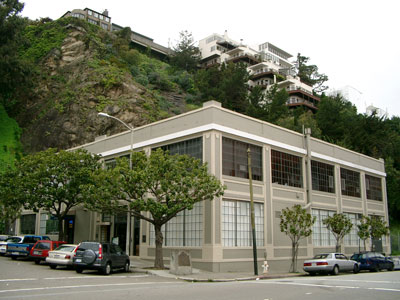
Farnsworth's Green Street Lab in San Francisco at 202 Green Street
Packard again recalls,
In the 1930s Terman's graduate course in radio engineering included visits to some of these firms. I remember visiting Kaar Engineering in Palo Alto, Eitel-McCullough in Burlingame, and Charlie Litton's shop, which would in time become Litton Industries in Redwood City. I also went to San Francisco to meet Philo Farnsworth, who was developing a television camera tube.
Terman encouraged Hewlett and Packard to follow these other electronics buffs and start a business of their own near Stanford rather than running off to more developed pastures, as so many of Stanford's students tended to do at the time. It took a couple of years for Hewlett and Packard to get their affairs in order, but in 1938 Hewlett found the famed garage, and the men started hammering away on a variety of projects.
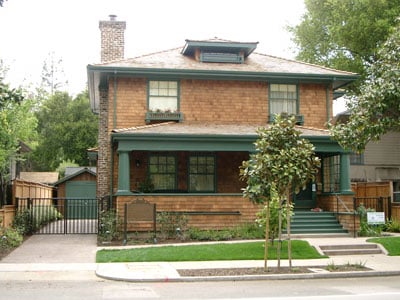
Hewlett and Packard's house at 367 Addison Avenue
Uncertain of what to base their business around, Hewlett and Packard went at products ranging from exercise machines to foul-line signals built for the local bowling alley.
Life was a bit more comfortable for Packard in those days. He lived in the main house near the garage with wife Lucile. Meanwhile, the bachelor Hewlett was confined to a small shack to the right of the garage.
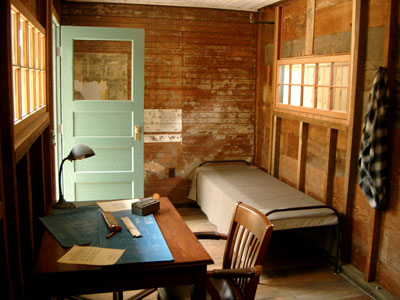
Hewlett's humble digs
Now we'll head to the actual garage.
By 1939, Hewlett had done some pioneering work on an audio oscillator. He, Packard and Terman decided the oscillator would make a fine "first" product for Hewlett-Packard.
The camaraderie of the electronics industry in those days served as a precursor for what would follow during the rise of the semiconductor industry in the 1950s and 60s and the rise of the PC and internet industries in the 1980s and 1990s. Companies would help each other out, and often swapped talent and/or gear with Stanford. Packard, for example, buddied up with Russ Varian and later Hewlett-Packard received a lot of help from Charlie Litton.
"(Litton) gave us access to his shop so we could do things we weren't able to do accomplish in the garage on our own," Packard said.
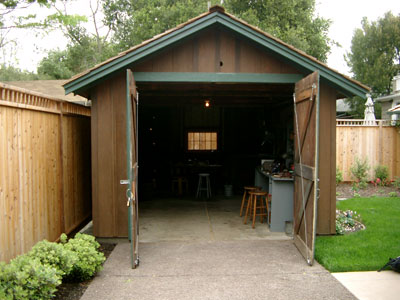
The HP Garage in all its glory
Hewlett and Packard, however, did much of the production work on the Model 200A oscillator at their garage and in their house.
When we started making the audio oscillators, we bought the cabinets but made the panels ourselves. We sawed them out of aluminum and drilled the holes. Then we'd spray-paint them at home and use the kitchen oven to bake the paint.
Lucile was said to have remarked that her roasts "never tasted the same" after they had baked the paint in the oven.
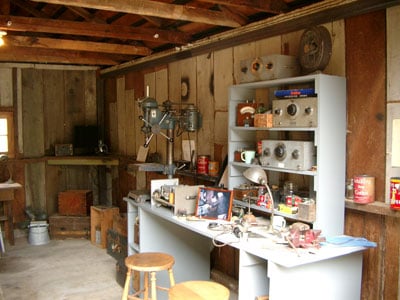
Inside the HP Garage with some Model 200As on display
Then I'd take the panels up to Charlie's and engrave all the designations on the panels through the paint. Next, we calibrated the dials by setting up a frequency standard. Then we marked the dial with a pencil and I'd go back up to Charlie's and engrave those pencil lines. In the beginning, each of the oscillators was individually calibrated. There were always a few tricks involved in using the engraving equipment, and Charlie knew them all. I suppose we could have eventually done many of these things on our own. But having Charlie Litton and his equipment there made an important difference during a period when time and money were very tight. He never saw us as competitors but always as compatriots.
The oscillator attracted immediate attention from a number of companies. But Disney's purchase of the product is the only buy to have entered into HP lore.
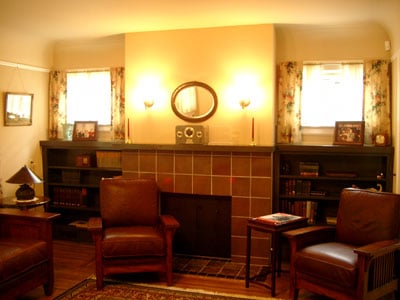
What the living room of the Addison house looks like today
While many have portrayed Disney's interest in what would become the Model 200B as a make or break moment for HP, Packard denies that this was ever the case.
"The truth of the matter is that with or without the Disney sale, Bill and I were determined to move ahead with our company."
HP Grows and Grows and Grows
In the Fall of 1939, two occurrences made life in the garage untenable. For one, HP had grown to the point where it needed more workers. After its first full year in business, HP brought in $5,369 and posted a $1,563 profit. Secondly, Hewlett had fallen in love with and married Flora Lamson. He could hardly bring the blushing bride back to a shack outside of Packard's house.
So, Hewlett and Packard acquired an office space near the corner of Page Mill Road and El Camino Real - two of the better known arteries in Silicon Valley. The old HP office is currently a non-descript building located behind a Cingular store.
Hopefully, a CEO or two will read this because the next part of the story is top-notch stuff.
Not long after setting up the new shop, Hewlett was called into service and spent most of World War II in the Army Signal Corps. Like many electronics companies in the area, HP benefitted from military spending during the war. Sales skyrocketed.
Luckily for the HP workers, Hewlett and Packard had set up a type of revenue sharing compensation plan before the war started. "It involved a complicated formula, but in essence it paid everyone a bonus, as a percentage of their base pay, should production exceed certain levels. General Radio's plan applied to engineers only. But Bill and I thought everyone at HP should be included. We wanted to recognize the contributions of each individual, not just a special group."
While in charge of a growing company and facing more pressures, Packard did not reward himself as handsomely as some CEOs might have at the time. Packard kept his salary even with Hewlett's military pay.
As HP expanded, it moved offices once again, heading up Page Mill Road to part of what was then the Stanford Industrial Park (now Stanford Research Park). Terman had led the effort to create this park near Stanford as a way of generating revenue for the university and as a way of attracting technology-based businesses to the area. The professor hoped that the proximity of the businesses would create a flow of talent between the different organizations and Stanford. The plan worked with Varian buying the first lease and then companies such as HP, General Electric and Lockheed following. The park is still the home of HP and myriad other companies ranging from financial services firms to bio-tech companies.
So, let's have a look at Hewlett and Packard's offices at the HP headquarters.
HP built up an almost magical reputation during the 1950s and 1960s. The company is credited with inventing the office cubicle, for example, so that workers could exchange ideas and move around the office. (Of course, this turned out to be more of a curse than a blessing for most.) In addition, Hewlett and Packard would push for policies such as leaving equipment lockers open so that workers could fiddle with experiments after hours or on weekends. They also continued to dish out generous compensation and tried to keep in contact with all employees by holding events such as BBQs where Hewlett and Packard would serve as grillmasters.
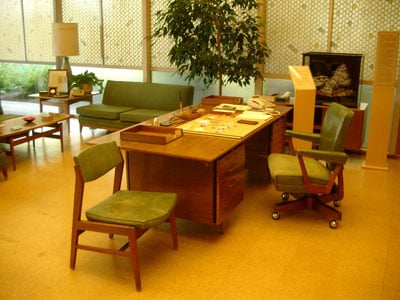
Hewlett's Desk
Hewlett and Packard championed the notion of an "open door policy" as well, where workers could come in at any time and voice their opinions. When it was suggested that this practice could lead to things being taken from the executives' offices, Hewlett decided to leave some cash on his desk to see if anyone grabbed it. No one did. Over the years, workers started leaving their own money on the desk, and HP donates the money to charity.
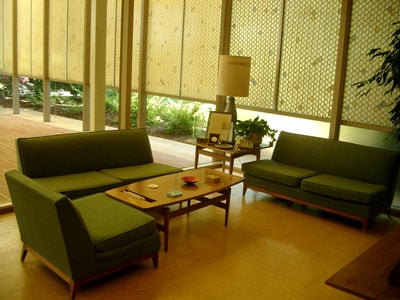
Hewlett's sitting area
Throughout the history of HP, Hewlett and Packard would swap top dog responsibilities depending on the circumstances of the moment. Packard, for example, ran the company when Hewlett went to the Army, and Hewlett ran the company when Packard left in 1969 to serve as US deputy secretary of defense. When together at HP, the two executives adopted a two-a-box style of management where their offices were connected. They could even see each other when seated at their desks by looking through the passageway created when the doors to the executive washroom were open.
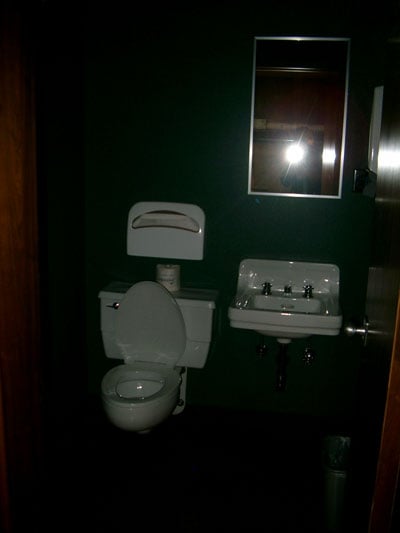
The no frills executive bathroom
Both men also shared a view of a Japanese-style garden outside of their offices.
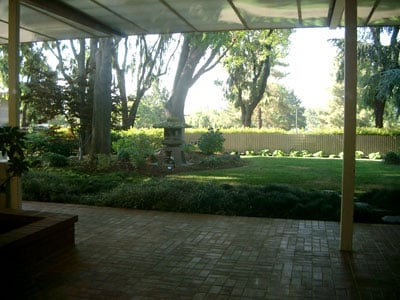
The HP Garden
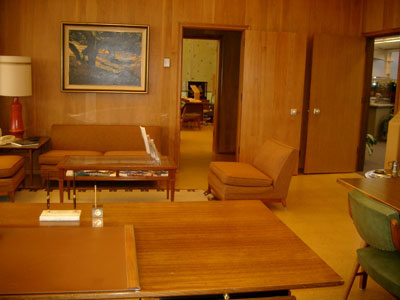
View from Packard's desk to Hewlett's desk
In many ways, it would be impossible for HP's current CEO to manage the company as Hewlett and Packard had intended. The co-founders found it difficult to maintain the personal, small company feel that HP cherished as it expanded around the world and gobbled up smaller firms. The impersonal nature of HP has only grown since the founders left with the company swelling in size.
This little walk down memory lane helps take us back to a time when a smaller HP was Silicon Valley's prime example of what a technology powerhouse in this region could and should look like. A number of Stanford graduates and employees have taken their own cracks at this vision since, including executives from Sun Microsystems, Cisco Systems, SGI, Yahoo!, and Google.
Without question, Hewlett and Packard set a high standard for others to follow. Even if HP didn't dabble much in silicon for its first decades, it did help Silicon Valley thrive.
(And not to leave the Compaq crew out. We have a charming song from the glory days.) ®